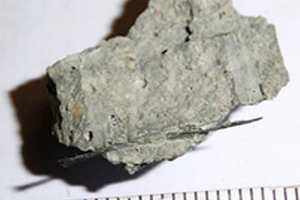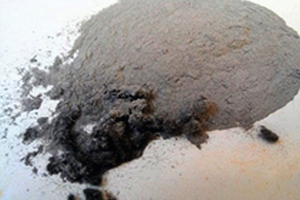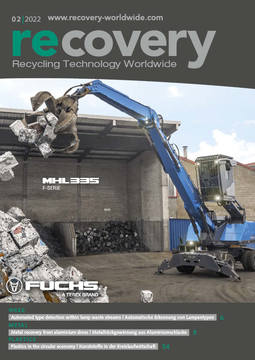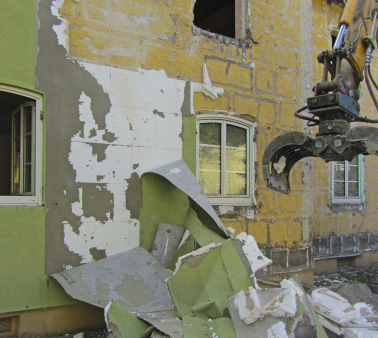An ideal building material but a recycling challenge
The use of carbon-fibre-reinforced plastics (CRP) in building is steadily advancing, despite significantly higher costs. Carbon-fibre-reinforced building materials (CF concretes) exhibit outstanding advantages (enormous reduction in mass, high durability and resistance to corrosion) compared to reinforced concrete. They are, in addition, sustainable, in view of the fact that these properties also entail savings on primary resources.
1 Introduction
Taking account of these findings, work has been going on more intensively on the implementation of research results, ranging from the „raw“ materials themselves up to the finished component, since around 2014. For Germany‘s largest research project in the field of construction, „C³ – Carbon Concrete Composite“, the federal government provided no less than 45 million € of funding from the Federal Ministry of Education and Research within the scope of the Zwanzig20 („Twenty20“) promotion initiative. The research teams involved can boast even now of prestigious awards: in 2015, the C³ consortium, headed by the consortial leader, Technical University of Dresden (TUD), was presented with the German Resources Efficiency Award for the development of this new and trailblazing composite building material. Then, in 2019, the team for the C³ project mentioned above took the Energy Globe World Award in Yazd (Iran), after which project worker Jan Kortmann (TUD) won in 2020 the Saxony Industrial Club 2019 innovation price. All this is extremely gratifying, but resources efficiency along the value chain and the circular economy demand and mean more. In addition to generation of resources, their production and the product-use phase, the consequences concerning the orderly return of all composite-material components used into the circular economy is also of great significance. Very frequently, the indisputable benefits are more than cancelled out after the end of the product life-cycle by severely heightened effort in the context of the classification of innovative composite structures, the elimination or removal of pollutants, and the implications for existing disposal scenarios. So how does recycling of this much vaunted lightweight building material, and how does its circular economy, look in practice?
At the Institute of Mineral Processing Machines (IART) of the TU Bergakademie Freiberg University of Resources (TU BAF), there has for a number of years now been work on, inter alia, the recycling of complicated composite components and modules in the spheres of mobility and regenerative energy, in which the most diverse range of materials are combined in the most advantageous way to produce so-called lightweight composites. In this context, extensive research work has also been performed on the recyclability of CF concretes, with special attention to the implications for the conception of existing conventional building-rubble recycling facilities and the reuse or suitability for landfill dumping of recyclates; these projects are reported below.
2 Use of CFRP in the building industry
As early as the 1999 to 2011 period, research into textile-reinforced concrete, on which the activities for the development of carbon-fibre reinforced concrete were based, took place in Germany within the scope of two special research fields of the German Research Foundation. Since 2014, work has been going on for the implementation of these results in practice in the so-called „C3 Carbon Concrete Composite“ project. Nowadays, more than 160 partners from industry and science are working in this project on the further development of this innovative building material. The world‘s first bridge for the State Horticultural Show in Oschatz in 2005 and, as a major project, the renovation of the listed ceiling of the canteen in the Zwickau Inland Revenue Office in 2008, are mentioned as commercial uses. There is, currently, a whole series of other applications both in the new construction field (pedestrian bridges, railway platform systems, wall and ceiling designs) and in the renovation of industrial structures and bridges (e.g. the Carola Bridge in Dresden, scheduled for completion in 2020). The first complete all-carbon-concrete building was finished („CUBE“) in Dresden in 2021, thus demonstrating the practicability of large-scale use [1]. The partial acceptance inspection for the first construction phase took place in May 2021 and in February 2022 the topping-out ceremony was held to mark the completion of the building shell [2]. As shown in Figure 1, the applications for CFRP in the building sector remain relatively low, at approx. 5 % worldwide [2], but precisely this will probably prove to be a serious problem in the context of recycling. This is discussed further below.
3 The state of the art in recycling of carbon-fibre reinforced concrete
Despite the severe regimentation of recycling in the building materials sector and the extremely high demands made on the resulting material qualities, building waste and, in particular, concrete components and remnants remain one of the most highly recycled forms of waste materials. The annual yield in non-reinforced and steel-reinforced concrete waste amounted in Germany to some 59 million t in 2016 [4]. In parallel to this, around 155 000 t of CFRP was used in 2018, of which around 7700 t (5 %) in the construction industry. On the assumption that some 80 % of this amount took the form of polymer-bound material (CFRP), this equates to approx. 6400 t of CFRP reinforcement. Assuming around 5 % are yielded as waste each year, a current total of around 320 t/a CFRP can be anticipated as the yield in building rubble. Referred to the EU (approx. 5 % of world input) and Germany (approx. 2 % of EU input), this means, with a CFRP input of 320/64 t/a, a waste yield of or 3.2 t/a. If a CFRP percentage in the reinforced components of approx. 1 % is assumed, this equates to around 320 t of such in Germany. The scale of the future challenges to recycling organisations becomes apparent when this is related to annual yield of non-reinforced and steel-reinforced concrete waste in Germany – the approximately 59 million t mentioned – and joint classification, collection and preparation in conventional preparation plants. Identification of CFRP-reinforced concretes within a large quantity of non-reinforced and steel-reinforced waste material appears to be possible only with unjustifiable economic effort, if at all. In order to avoid overshoots of limits for CF contents with certainty, the on-line inspection of all building waste would be necessary. Such systems are, at best, only at the development stage, and would further exacerbate the cost-side of the already precarious economic situation of RC plant operators.
On the recycling of carbon concrete – currently predominantly from waste from component production – there has been, up to now, only scanty data supported by experimental analyses. The article „Materials cycle of carbon concrete“ [5] contains only the statement that „the carbon-concrete construction method is a closed materials circuit“, i.e. the recovery of the individual components with removal of disruptive materials has been solved. Concerning the separation of concrete and CFRP, it is stated that the comminution of the material from demolition work can be accomplished using conventional crusher technology (jaw crushers). Here, then – according to the report – the reinforcement is successfully separated from the concrete. Subsequent sorting using a sensor-based system is, in principle, achievable, but slight fibre losses are shown in the material balances and will be attributable to the particulates emissions and impurities of slight fines contents. The subject of recycling is, nonetheless, being further pursued in the C3 joint program. Kortmann studied in his dissertation [6] the extent to which health and recyclability might constitute a potential barrier to market entry for the carbon concrete composite building material. Recycling processes have been analysed and the valorisation options for the material fractions yielded outlined for the question of whether and in which form this building material can be reused. Scarcely any attention was devoted in this context to the fines and particulates, which are inevitably caused in significantly larger amounts in the mechanical preparation of carbon concrete using the high-speed comminution technology (impact crushers) usually installed in conventional plants.
4 Potential CFRP hazards
Kortmann [6] showed in the above-mentioned dissertation, in conformity with IART‘s results, that no respirable fragments of fibres in the magnitude range of the WHO definition could be detected. This led to the conclusion that no provisions beyond the customary health and safety regulations were currently necessary. Since the respirability of fibre-containing waste is, however, only one sub-aspect of the hazard, corresponding hazard potentials caused, in particular, by particulates and fine fractions should be assumed when all fractions yielded during component production, component use and the recycling process are included. Unavoidable CF particulates emissions, which constitute a relevant hazard for humans and for equipment, occur in all these life-cycle phases of carbon concrete. Extensive investigations into the recycling of carbon-fibre-containing waste conducted at the RWTH Aachen University [e.g. 7, 8] indicated that fibre fragments to be considered critical in this respect occur from CFRP during thermal treatment, in particular. In addition, these can also cause fires in the electrostatic precipitators of the incineration or dedusting systems. Analogous results are also reported in medical and military-technology articles [e.g. 9, 10]. The conclusion: despite the known hazard situation, the environmental authorities have up to now not stipulated any limits for tolerable CF contamination levels. The disposal organisations and purchasers of potential CF-containing waste or recycling products – construction contractors, incineration plants, landfills – react to the uncertainty thus arising with drastically higher prices and unequivocal scepticism; the latter may even extend to complete refusal to accept such materials. If it is not CFRP-reinforced waste components, there could be serious sales problems for the recycling organisations involved and, ultimately, the presence of an additional economic burden.
Here, not only the specification of limits, but also a still non-existent practicable analysis system for low fibre contents would be not only helpful but, in fact, urgently necessary.
5 Experimental recyclability analyses
In order to obtain a substantiated base of data for the assessment of the hazard situation, the CF dissipation in the products of a building-rubble recycling plant was analysed some time ago at the IART of the TU BAF [e.g. 11, 13]. Experimental analyses using artificially generated test objects (Figure 2 right) and defined carbon-fibre-containing reinforcement contents [12] were performed using a number of different comminution machines currently customarily in use in building-rubble recycling. In this way, it was possible to obtain a reliable CFRP balance via Rc,CFK yield. The concrete matrix consisted of fine concrete (Pagel Tudalit), while the substrate TEN CF800 (SGL C30 T050 EPY) served as the reinforcement material. The CFRP content cCFK in the concrete constituent varied here between 0.8 and 1.6 %.
The digestion of the test objects was accomplished on a laboratory scale using a pilot-scale jaw crusher or a hammer crusher (Figure 3), thus corresponding to pressure and impact comminution. The effectiveness of comminution was then characterised by test screening and presented in the form of particle-size distribution of the total product and of the composite components (example: jaw crusher, Figure 4). For this purpose, the fibre content in the fractions of screen classification was firstly determined visually. During screen classification, the carbon fibres were clumped together in the fine particle-size fractions. Such clumping could then be separately registered and weight. Since not all fibre remnants could, with certainty, be removed, it can be assumed that the data concerning fibre-contamination constituted minimum values.
Results – Jaw crusher
The results of comminution indicated that the degree of digestion in the jaw crusher is unsatisfactory (Figure 5 left). Many non-broken-down residual composites occurred. Only < 1% of cleanly broken-down composites, i.e. correctly separable CFRP reinforcements, was detected in the model case analysed. The percentage by mass of residual composites in the coarse fraction (concrete matrix with CFRP) is unequivocally too high, at 21 %. In addition, blockage of the crusher chamber occurred repeatedly during these tests. The reason for this was the fact that, as a result of compressive stresses, obviously only a selective comminution of the brittle concrete matrix, but not of the flexible reinforcing substrate, was possible.
Subsequent screen classification resulted in preparation products, the fine fractions of which exhibited all visually perceptible CF impurities. The fines fraction < 1 mm of the jaw crusher was comparatively small, at around 17 %; it must nonetheless be concluded that the composite components cannot be cleanly separated using this processing procedure.
Results – Hammer mill
The comminution products (Table 1) document, with residual composite percentages of Rm < 0.1 %, the extremely good breakdown („digestion“) performance of these comminution technologies (Figure 5 middle). With a CFRP yield of Rc of approx. 86 %, the predominant portion of the CFRP reinforcements used in the model composite component is present in free form as relatively coarse structures and is thus theoretically easily separable in the downstream sorting stages. The high percentages by mass of fines < 1 mm (Rm around 82 %), which contain only extremely slight CF contamination at CFRP contents of < 0.1 %, however, might be disadvantageous, however. Higher fibre contents are exhibited, on the other hand, by the coarser concrete-matrix > 1 mm (Rm around 16 %), at 0.15 % and the dedusting product < 200 µm (Rm around 1.3 %), at 4.3 %.
All in all, it is also apparent in this case that all fine fractions < 1 mm contain optically visible CF contamination (Figure 5 right). A clear correlation between the CFRP yield RC CFK and crushing energy (crushing duration, crushing velocity) and a slightly less pronounced correlation with the parameter CFRP content cCFK can thus be concluded (Figure 6).
6 Conclusions and summary
Informationally valuable and substantiated deductions concerning the dissipation of carbon fibres in the preparation products from CF concretes can be drawn from the results shown of the preparation tests performed on a pilot-scale scale, which were also augmented with tests using alternative, commercially available CFRP reinforcements (with analogous results). The CFRP yield, Rc,CFK in the various preparation products is suitable, in particular, as a characteristic parameter.
Applying the discoveries obtained concerning yield to a conventional building-rubble preparation plant with a throughput of 10 t/h, the CFRP contents in the individual preparation products as per T able 2 are calculated (reference CFRP content per 10 t building rubble = 107 kg):
From this, it is apparent that satisfactory separation of the relatively coarse, freely present reinforcements from mixtures of building waste could be perfectly possible following breakdown comminution as described in Kortmann et al. [6]. Whether the relatively expensive sensor-assisted sorting technology proposed there should be used, operating with a compressed-air extraction system (6 – 8 bar), will depend on the economic situation of the recycling company. Considerable quantities of CFK particles or CF will, in addition, be present in the fines fractions generated inevitably in breakdown comminution, there at present being, to our knowledge, no economically practicable potentials for detection and separation of these, in particular. The comparatively small masses of ultra-fine CF impurities constitute, however, due to their minimal bulk densities, a significant volume of contamination, which should be extremely well detectable, depending on the level of dilution. Further research work will in the future be necessary for the solution of this preparation problem. An interesting wet-mechanical preparation concept for this subject has been presented at the Institute of Mineral Processing Machines (IART) of the TU BA Freiberg in the scope of the German Federal Environmental Foundation‘s „Carbon Revive“ project in the years 2018 to 2020. The detailed results and the process proposal derived were defended as a dissertation in late 2021.
The investigations described illustrate that optically visible ultra-fine CFRP particles and, probably, tiny fragments of CF, occur in the fine fractions of building-rubble recycling, largely irrespective of the types of reinforcement fibres used. It may be anticipated, analogously to other building-rubble contaminants, that the legislator will in the midterm stipulate corresponding limits which would put in question the reuse of such fibre-contaminated preparation products. It would be conceivable, for example, that such limits would endanger the use of crushed sand obtained from building-rubble preparation plants as a landfill construction material for pathway construction or covering. Despite the currently low quantities of waste and precisely due to the indisputable benefits of CFRP concrete, the problems associated with CF contamination in building rubble should not be denied or ignored, and researchers should establish and confront what is needed. The most important challenge will, in this context, probably be identification of CFRP structures in the feed material and ultra-small CF content amounts in the fine fractions of conventional building-rubble preparation. Initial conceptual solutions for this are currently at the development stage in the IART of the TU BA Freiberg.
[01] www.bauen-neu-denken.de /29.03.2019 [02] Press release by TUD dated 06.02.2022: Der Rohbau des Carbonbetonhauses CUBE erfolgreich fertiggestellt
[03] Witten, E.: Composite Marktbericht 2018, Carbon Composites und verstärkte Kunststoffe AVK aus http://avk-tv.de
[04] Monitoring-Bericht D 2016 - Aufkommen und Verbleib mineralischer Bauabfälle im Jahr 2016; Kreislaufwirtschaft Bau; Bundesverband Baustoffe – Steine und Erden e. V. Mineralische Bauabfälle)
[05] www.bauen-neu-denken.de / 25.10.2019 [06] Kortmann, J.: "Verfahrenstechnische Untersuchungen zur Recyclingfähigkeit von Carbonbeton"; dissertation, TU Dresden, December 2019
[07] Quicker P.: Wohin mit den Hightech- Materialien – Entsorgung CFK-haltiger Abfälle; article for ITAD podium discussion dated 25 – 31 May 2016, Munich
[08] Stockschläder, J.; Quicker, P. et al.: Behandlung von Carbonfaser-haltigen Abfällen in Hausmüllverbrennungsanlagen. In: Mineral. Nebenprodukte u. Abfälle 5. TK-Verlag GmbH Neuruppin (2018) S. 87 ff [09] Seibl, S.: Gesundheitsgefährdung durch respirable Kohlenstoff-fasern beim Abbrand von Carbonkunststoffen. www.universimed.com dated 4 May 2017
[10] Mattenklott, L. u. Van Gelder, R.: Carbonfasern und carbonfaser-verstärkte Kunststoffe - Teil 1: Charakterisierung, Exposition, Bewertung und Schutzmaßnahmen. Gefahrstoffe - Reinhaltung der Luft 79 (2019) No. 9, pp. 317-322
[11] Jäckel, H.-G.: CF-bewehrte Betone – ein künftiges Entsorgungsproblem? Ausgewählte Ergebnisse zur Recyclingfähigkeit. Vortrag zur 4. Fachkonferenz "Stärkung des Einsatzes von mineralischen Recycling-Baustoffen"; 13 February 2019, Potsdam
[12] Nazaret, A.: Untersuchungen zur Aufbereitung kohlefaserverstärkter Betonelemente; Master's thesis, TU Bergakademie Freiberg University of Resources; IMB-RM 2018
[13] Jäckel, H.-G., D. Hamann et a.: Recycling Carbonfaser-verstärkter Betonteile – Konsequenzen für die Deponiefähigkeit von Produkten des Bauschuttrecyclings. Paper for landfill workshop, 12 and 13 November 2020, Zittau
Authors:
Dr.-Ing. Hans-Georg Jäckel, MSc. D. Hamann, Dr.-Ing. Thomas Krampitz, Prof. Dr.-Ing. Holger Lieberwirth
alle TU Bergakademie Freiberg, Institut für Aufbereitungsmaschinen und Recyclingsystemtechnik (IART)

![1 Global use of CFPR, 2018; (worldwide, after [1])](https://www.recovery-worldwide.com/imgs/1/7/5/5/4/7/1/tok_04c4a9d4d3a0e657e03578e29902fb8f/w300_h200_x600_y326_Bild_1-1ffc491887d39397.jpeg)
![2 Cross-section of a concrete test object (above), reinforcement mesh (middle) and test object programme (below); after [10]](https://www.recovery-worldwide.com/imgs/1/7/5/5/4/7/1/tok_b0a228d27431f5fc7ccc76b9a5ef762c/w300_h200_x376_y372_Bild_2a-9dd2d132dc274ee2.jpeg)
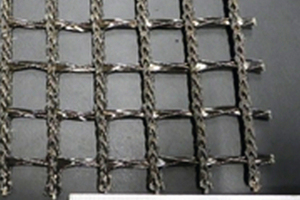
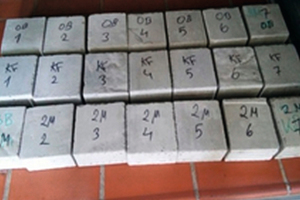
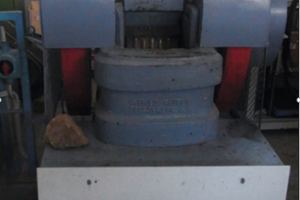
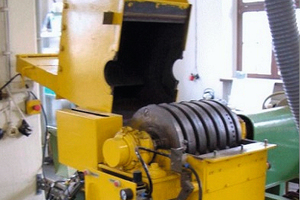
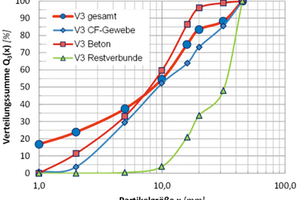
![5 Residual composite-attachment from jaw crusher (left), hammer mill (middle), CF contamination in the fines fraction of the hammer mill (right); after [10]](https://www.recovery-worldwide.com/imgs/1/7/5/5/4/7/1/tok_67b82af86312047743331d904a87e3ff/w300_h200_x300_y330_Bild_5a-d01acc8c2263459e.jpeg)
